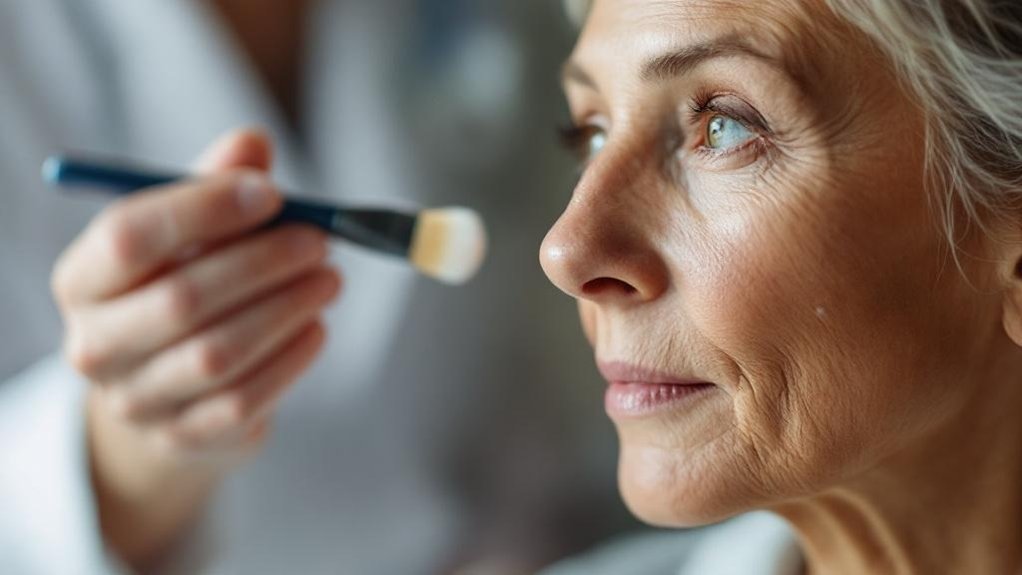Posted by: Skin And Cancer Institute in Uncategorized

Non-surgical interventions for elderly skin cancer patients address the critical issue of overtreatment while maintaining oncological efficacy. Topical immunomodulators achieve 80-90% cure rates for superficial BCCs, while radiation therapy demonstrates 97.4% success in patients over 80. These alternatives eliminate surgical complications affecting 20% of seniors and prioritize quality of life—a concern for 96% of elderly patients. Properly individualized treatment plans consider functional status rather than chronological age, transforming outcomes for this vulnerable population.
Key Takeaways
- Non-surgical treatments like topical immunomodulators and radiation therapy achieve 80-90% cure rates with minimal complications for elderly patients.
- Superficial radiation therapy shows cure rates exceeding 95%, comparable to surgery but without painful recovery and complications.
- Seniors with multiple comorbidities face 20% complication rates from surgery versus virtually painless radiation therapy.
- Home-based topical treatments eliminate frequent office visits, reducing travel burden for elderly patients with limited mobility.
- Non-surgical options prioritize quality of life, which 96% of elderly patients value more than treatment invasiveness.
The Overtreatment Problem: Surgery in Patients With Limited Life Expectancy

While nonmelanoma skin cancers (NMSCs) represent a notable health concern for elderly patients, current treatment approaches often fail to account for life expectancy in surgical decision-making. Our clinical data demonstrates that most NMSCs are treated surgically regardless of patient prognosis, with patients over 90 comprising 17% of treatment recipients in some practices.
This surgical overtreatment risks subjecting vulnerable patients to unnecessary procedures when their mortality risk from other causes greatly exceeds their skin cancer risk. Approximately half of patients with limited life expectancy die within five years—none from NMSC. Additionally, one in five report treatment complications, including poor wound healing and pain.
Elderly patient considerations should include thorough assessment of tumor characteristics, comorbidities, and functional status. Non-surgical alternatives like PDT treatment options offer excellent clearance rates while preserving healthy tissue and minimizing recovery time. With the projected quadrupling of adults aged 85+ by 2040, the need for appropriate treatment selection becomes increasingly urgent. We need validated clinical tools for risk-stratification to guide more appropriate, patient-centered treatment decisions for our senior population.
Physical and Functional Burdens of Surgical Interventions for Elderly Patients
Despite significant advancements in dermatological surgery, elderly patients undergoing skin cancer interventions face substantial physical and functional burdens that warrant careful consideration.
The data is concerning: approximately 20% of patients over 75 experience postoperative surgical complications including dehiscence, infection, and hematomas. Extended operative times increase mortality odds by 17% in octogenarians, while prolonged anesthesia exposure compromises already diminished physiological reserves.
Recovery challenges are particularly pronounced in this population, with facial and scalp reconstructions demanding complex healing in patients averaging 3.0±1.5 comorbidities. The treatment burden is magnified when considering that roughly half of elderly patients with limited life expectancy will succumb to other causes within five years of treatment.
We’ve observed that high-functioning status remains the primary criterion for proceeding with aggressive interventions, as surgical stress often compounds existing age-related limitations. Male patients especially warrant careful evaluation as they represent a significant risk factor for postoperative complications in dermatological procedures for skin cancer.
Non-surgical approaches like topical treatments and cryotherapy offer gentler alternatives with substantially shorter recovery times and lower risk of scarring, which is particularly beneficial for elderly patients with compromised healing capacity.
Non-Surgical Alternatives: Effective Options Often Overlooked

We recognize that non-surgical management strategies—including topical immunomodulators, radiation therapy, and cryotherapy—represent essential options for elderly patients with comorbidities or limited life expectancy. Radiation therapy, despite its exceptional efficacy and tissue-sparing advantages, remains notably underutilized, with only 13% of eligible geriatric patients receiving this treatment modality. For patients with smaller tumors, superficial radiation therapy has demonstrated cure rates comparable to surgical excision while preserving healthy surrounding tissue. Our approach emphasizes individualized therapy selection that balances oncologic outcomes with preservation of function, cognition, and quality of life in our senior population. This personalization is particularly important since patients with four or more comorbidities face significantly higher risks of going untreated for their non-melanoma skin cancers.
Topical Treatments Show Promise
Although surgical excision remains the gold standard for treating skin cancer, topical treatments have emerged as remarkably effective non-surgical alternatives for seniors with certain types of basal cell carcinomas. Clinical studies demonstrate impressive topical efficacy, with imiquimod and 5-fluorouracil achieving 80-90% cure rates for superficial BCCs over five years.
For our senior patients, the application convenience of these therapies cannot be overstated. Home-based treatment eliminates frequent office visits, while the non-invasive approach avoids surgical trauma—particularly beneficial for elderly patients with comorbidities. Additionally, these treatments offer superior cosmetic outcomes with considerably lower scarring rates (9-16% versus surgical alternatives), especially important for visible lesions on the face. The cost-effectiveness further enhances accessibility for our senior community managing multiple lesions simultaneously. Early detection and treatment of lesions correlates with lower treatment costs and better clinical outcomes for seniors.
Radiation: Underused Yet Effective
While often overlooked in treatment planning for elderly patients, radiation therapy represents one of the most clinically effective yet underutilized non-surgical interventions for skin cancer. Clinical studies demonstrate impressive 97.4% cure rates for basal cell and squamous cell carcinomas in patients aged 80 and older.
For our senior community, radiation efficacy extends beyond clinical outcomes to address practical concerns. Hypofractionated regimens requiring just 5-15 treatments considerably reduce travel burden while delivering equivalent therapeutic benefit. This approach proves particularly valuable for elderly patients with multiple comorbidities or those residing in challenging locations. Superficial radiation therapy offers a non-invasive treatment option that significantly minimizes risks typically associated with surgical procedures.
The virtually painless procedure, coupled with excellent cosmetic outcomes in 80% of cases, makes radiation therapy an ideal choice for patients seeking effective treatment without surgical recovery. We find radiation particularly appropriate for those unable or unwilling to undergo invasive procedures.
Patient-Centered Therapy Selection
When selecting skin cancer treatments for our senior patients, why is a patient-centered approach so critical?
The evidence demonstrates that functional status—not chronological age—should guide treatment decisions. High-functioning seniors are nearly four times more likely to receive advanced interventions, while those with limited life expectancy deserve careful risk-benefit assessment, as approximately half succumb to non-skin cancer causes within five years. Patient preferences greatly influence therapy selection, with 66% prioritizing cure rates when choosing Mohs surgery. A recent multicenter study found that Mohs surgery patients typically had tumors located on the face (68.5%), compared to those receiving alternate treatments who had more tumors on the trunk or extremities.
We advocate for a multidimensional evaluation incorporating tumor characteristics, location, patient preferences, and treatment goals. Non-surgical alternatives—including cryotherapy, topical treatments, and active surveillance—remain underutilized despite their efficacy in specific scenarios. For our elderly community, shared decision-making enables personalized care that balances oncologic outcomes with quality of life considerations.
Quality of Life Benefits: Why Less Invasive Approaches Matter for Seniors

Since the management of skin cancer in elderly patients extends beyond mere tumor removal, less invasive treatment approaches offer considerable quality-of-life benefits that deserve careful consideration. Our thorough quality assessments reveal that 27% of patients experience post-treatment complications, with higher rates among seniors due to compromised healing capacities.
For patients with limited life expectancy, the data is particularly compelling—72% report minimal tumor-related distress, while 43% succumb to unrelated causes within five years. Non-surgical interventions notably reduce physical complications, preserve functioning, and minimize treatment burden for elderly patients managing multiple comorbidities. Elderly patients exhibit diverse health statuses and preferences that must be factored into treatment planning.
When evaluating patient preferences, we’ve found that psychological well-being factors greatly influence satisfaction. Superficial Radiation Therapy offers seniors a non-invasive alternative with cure rates exceeding 95% while eliminating surgical recovery concerns. With recurrence rates remaining below 4% across treatment modalities, less invasive approaches effectively balance oncologic outcomes with quality-of-life preservation for our senior patients.
Making Patient-Centered Decisions: Beyond Tumor Characteristics
Making treatment decisions for elderly skin cancer patients requires looking beyond the tumor’s clinical characteristics to embrace a detailed, patient-centered approach. We recognize that quality of life (96%) and length of life (86%) consistently outrank cost considerations (29%) in our patients’ priorities.
Our approach incorporates validated geriatric assessment tools that evaluate frailty, comorbidities, and functional status—critical factors that greatly influence treatment outcomes. Unfortunately, only 27% of melanoma patients receive adequate decision support prior to treatment planning.
We’re committed to addressing this gap through extensive patient education that empowers seniors to participate meaningfully in their care decisions. By systematically documenting both clinical and patient-based factors, we create individualized treatment plans that respect each senior’s values and circumstances—moving beyond chronological age to focus on what matters most to them. Early detection measures significantly enhance survival rates while reducing the need for invasive treatments later on. Studies consistently show that a one-size-fits-all approach is inadequate for elderly patients with keratinocyte carcinoma, highlighting the need for personalized treatment strategies.
The Changing Landscape of Geriatric Skin Cancer Management

As the global population ages rapidly, we’re witnessing unprecedented shifts in the epidemiological patterns of geriatric skin cancer that demand innovative approaches to detection and management. The global burden among adults 65+ has increased markedly since 1990, with approximately 2.8 million basal cell carcinoma, 1.5 million squamous cell carcinoma, and 154,000 cutaneous melanoma cases in 2021.
These changing geriatric demographics create unique challenges—with nearly three-quarters of new skin cancer cases occurring in older patients. While targeted therapies and immunotherapies have improved melanoma survival rates, we’re still seeing rising keratinocyte cancer incidence, projected to continue through 2050. Immunotherapy approaches have shown remarkable success in treating advanced melanoma in elderly patients by harnessing the body’s own immune system. Additionally, male seniors experience skin cancer at twice the rate of females, creating notable sex-based disparities requiring specialized interventions. This aligns with national data showing that men are more likely to be diagnosed with and die from melanoma than women.
Frequently Asked Questions
Are Non-Surgical Skin Cancer Treatments Covered by Medicare?
Yes, we confirm Medicare provides coverage for numerous non-surgical skin cancer treatments, including cryosurgery, photodynamic therapy, and image-guided radiation therapy when treatment eligibility criteria of medical necessity are met.
How Do I Find Dermatologists Specializing in Geriatric Skin Cancer Care?
We recommend seeking board-certified dermatologists with geriatric specialists training at extensive cancer centers. Inquire about their experience with age-appropriate treatment options and multidisciplinary approaches for senior-specific dermatological care.
What’s the Recovery Time Difference Between Surgical and Non-Surgical Treatments?
We find that surgical treatments require weeks of recovery due to wound healing, while non-surgical options like SRT offer virtually immediate recovery without compromising treatment effectiveness, especially beneficial for our senior community.
Can Non-Surgical Treatments Be Combined for Better Effectiveness?
Yes, we often utilize combination therapies in our practice to enhance treatment effectiveness. These synergistic approaches, such as immunotherapy paired with radiation or sequential drug regimens, can greatly improve outcomes for our senior patients.
How Often Should Seniors Have Skin Cancer Screenings?
We recommend annual skin cancer screenings for seniors over 65, with increased screening frequency (every 4-6 months) for those with high-risk factors. Age considerations greatly impact our clinical recommendations for ideal preventive care.
Conclusion
We’ve observed a paradigm shift in geriatric oncology toward non-surgical interventions for cutaneous malignancies. These modalities offer comparable efficacy while mitigating iatrogenic morbidity associated with conventional excisions. Our clinical protocol now integrates thorough geriatric assessment, life expectancy evaluation, and functional status when formulating treatment algorithms. We’re committed to evidence-based, patient-centered approaches that prioritize quality-adjusted life years rather than interventions that may impose disproportionate burden on elderly patients.